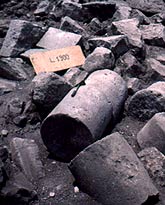
Columns in Western Quarter
The most dramatic episode is no doubt the last stand of the defenders of Gamla. In this context, Gamla is sometimes called 'Masada of the Golan' or ‘Masada of the North’, a term unacceptable to me.
The general public — and even the late Menachem Stern (1982:384) — is under the impression that just like at Masada, at Gamla too a mass suicide took place.
True, at both sites dramatic episodes of the Great Revolt were played out; both are symbols of heroism for the modern state of Israel and both are important historical and archaeological sites. But here the similarities end. Masada was conceived of and built as a desert fortress and served as such throughout its existence. During the revolt it was held by a group of several hundred sicarii and their families . Gamla on the other hand, evolved as a city and existed as such, relying mainly on natural fortifications. Josephus’ recurring reference to the citadel of Gamla (Life 11, 24, 36) is misleading. I have suggested above that Gamla may have been a fortified Seleucid outpost until the days of Alexander Jannaeus , but during the first centuries BCE and CE it was an unfortified city and certainly not a citadel. Although the crest of the ridge at Gamla was not excavated, thorough surveys have not revealed any remains of a citadel — akra — in the sense of a fortified building. There are a few scattered building stones on the ridge, and a single column drum lies just below the crest above the western quarters, but the remains are not substantial enough to reconstruct a massive defensive building. Had one existed, it would be difficult to account for Josephus’ complete silence about it, especially as a refuge or a last stand for the defenders. Thus, ¥kra at Gamla simply refers to the crest of the ridge.
No matter how critically — or uncritically — we read the suicide story of Eleazar Ben-Yair and his comrades (War VII: 8:2-9:2), at Masada no actual battle was fought. At Gamla however, a very real battle took place, at the end of which, when there was no more hope,
‘They flung their wives and children and themselves too into the immensely deep artificial ravine that yawned under the citadel. In fact, the fury of the victors seemed less destructive than the suicidal frenzy of the trapped men; 4000 fell by Roman swords, but those who plunged to destruction proved to be over 5000’ (10, §79–80)
Discussion on mass suicide in the Hellenistic-Roman world — real or literary — is beyond the scope of this paper, but has been amply discussed elsewhere. I propose to take a more pragmatic two-step approach to disproving the suicide story.
First, the only place along the crest of the ridge where there is a vertical cliff high enough for someone falling off it to die with reasonable certainty is at the summit, which can only be reached with some difficulty, by clambering over large boulders. Today the summit area can accommodate a few score people at most. In antiquity it may indeed have been larger, as earthquakes certainly brought down some massive boulders, but not by much. Even if we accept only 500 people, not 5000, standing on the ridge, it would be physically impossible for all but a few to reach the summit and jump headlong to their deaths. The rest would not have made it.
The remainder of the ridge on the north simply slopes down, though steeply indeed, to the gorge below.
Second, contrary to the time afforded to Eleazar Ben-Yair on Masada to make his speech and persuade his comrades to commit suicide, it is hard to imagine that the people at Gamla would have had the presence of mind in the midst of the fighting to decide on carrying out a mass suicide.
The truth, which Josephus wanted either to distort or ‘touch up’ in a literary way, is simply that the remaining defenders and townspeople were trying to flee down the steep northern slope in panic, with the inevitable result that many were trampled underfoot and died. I believe that some of the more agile actually reached the gorge, and thence — safety. For an observer (Josephus?) standing on the Deir Qaruh ridge and looking at this drama unfolding, it may indeed have appeared as a mass suicide.
Additional Articles ...